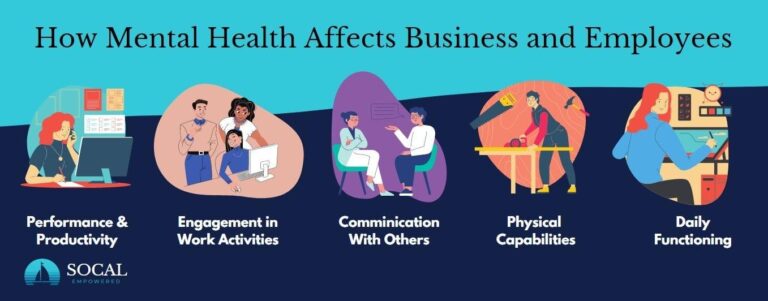In today’s fast-paced and demanding work environment, mental health has become an essential topic that can no longer be overlooked. Navigating mental health challenges at work is a reality many professionals face, yet conversations around this sensitive issue often remain clouded by stigma and misunderstanding. This guide aims to provide practical insights and strategies for recognizing, managing, and supporting mental well-being in the workplace. Whether you’re an employee seeking ways to cope or a manager hoping to foster a supportive environment, understanding how to address mental health challenges professionally is key to promoting a healthier, more productive workforce.
Table of Contents
- Understanding Common Mental Health Issues in the Workplace
- Creating a Supportive Environment for Employee Wellbeing
- Implementing Practical Strategies to Manage Stress and Anxiety
- Accessing Professional Resources and Building Resilience
- Final Thoughts
Understanding Common Mental Health Issues in the Workplace
Workplace mental health often revolves around navigating a few key challenges that employees frequently encounter. Among these, stress, anxiety, and depression stand out as the most prevalent. Stress typically arises from heavy workloads, tight deadlines, or conflicts with colleagues, leading to decreased productivity and burnout if left unaddressed. Anxiety can often manifest subtly through persistent worry, restlessness, or difficulty concentrating, impacting an individual’s performance and well-being. Depression, while more complex, may lead to feelings of hopelessness, fatigue, and withdrawal, creating important barriers to engagement and collaboration within the team.
Understanding these common issues can empower managers and colleagues to foster a supportive environment.Look out for signs such as:
- Frequent absences or tardiness
- Noticeable drop in work quality or motivation
- Social withdrawal or changes in communication patterns
- Physical symptoms like headaches or excessive fatigue
By recognizing and addressing these symptoms early, organizations can implement effective strategies that prioritize mental well-being, such as employee assistance programs, flexible work arrangements, and open communication channels, ensuring a healthier, more productive workplace.
Creating a Supportive environment for Employee Wellbeing
Fostering a culture where mental health is openly discussed and supported is essential for employee wellbeing. Organizations that prioritize psychological safety encourage employees to seek help without fear of stigma or reprisal.Implementing policies that promote work-life balance, such as flexible hours or remote work options, signals to employees that their holistic health matters just as much as their productivity. Leadership plays a critical role here; managers should be trained to recognize signs of distress and to respond with empathy and resources rather than judgment.
Creating a supportive environment also means providing tangible resources that help employees manage stress and mental health challenges. This can include:
- Access to confidential counseling or Employee Assistance Programs (eaps)
- Mental health awareness workshops and training sessions
- Regular check-ins focused on wellbeing rather than just performance metrics
- Physical spaces designed for relaxation or mindfulness practices
Companies that weave these elements into their culture not only enhance employee satisfaction but also unlock greater creativity and resilience across teams.
Implementing Practical Strategies to Manage Stress and Anxiety
Stress and anxiety often manifest subtly at work,making it essential to adopt proactive techniques that ground your well-being amidst daily pressures. Start by incorporating mindfulness exercises—even brief moments of focused breathing or meditation can reset your mental state and improve concentration. Additionally,establishing clear boundaries between work and personal time prevents burnout and fosters a healthier workflow. Prioritize tasks with realistic deadlines, and don’t hesitate to delegate when possible. These practical adjustments not only alleviate immediate stressors but also cultivate long-term resilience against workplace anxiety.
Effective management also involves leveraging supportive environments and resources. Consider building a network of trusted colleagues to share challenges and solutions,creating a sense of solidarity that can lessen feelings of isolation. Utilize available employee assistance programs or mental health apps tailored to workplace wellness. Remember to maintain physical health through regular exercise and balanced nutrition, as the mind and body are intricately connected. By integrating these strategies into your routine, you empower yourself to navigate stress with confidence and clarity.
Accessing Professional Resources and Building Resilience
When facing mental health challenges at work, leveraging professional resources can make a significant difference. many organizations now offer Employee Assistance Programs (EAPs), which provide confidential counseling and support tailored to workplace stressors. Additionally, consulting with licensed mental health professionals such as therapists or counselors can equip you with personalized coping strategies and therapeutic interventions. Don’t hesitate to explore external support networks like industry-specific support groups or mental health advocacy organizations. These resources can offer not only practical advice but also a community that understands the unique pressures you’re navigating.
building resilience is equally essential for maintaining mental well-being amidst workplace challenges. Simple daily habits such as mindfulness meditation, setting boundary between work and personal life, and engaging in regular physical activity can enhance your emotional stamina.It’s also vital to cultivate a mindset that views setbacks as opportunities for growth rather than failures. Consider integrating resilience-building techniques such as:
- Journaling to process emotions and track progress
- Seeking constructive feedback to improve rather than criticize
- Developing strong peer support through open, honest conversations
By proactively accessing professional support and nurturing resilience, you empower yourself to face mental health challenges with strength and clarity, fostering long-term success in your career.
Final Thoughts
Navigating mental health challenges at work is an ongoing journey that requires awareness,empathy,and practical strategies. By fostering open communication, utilizing available resources, and prioritizing self-care, both employees and employers can create a healthier, more supportive workplace environment.Remember, addressing mental health is not a sign of weakness but a vital step toward overall well-being and professional success. as you move forward, keep these insights in mind—because mental health matters, at work and beyond.

